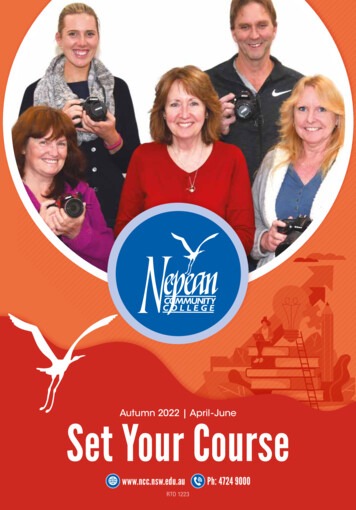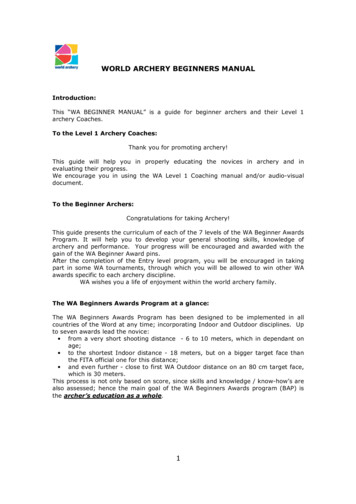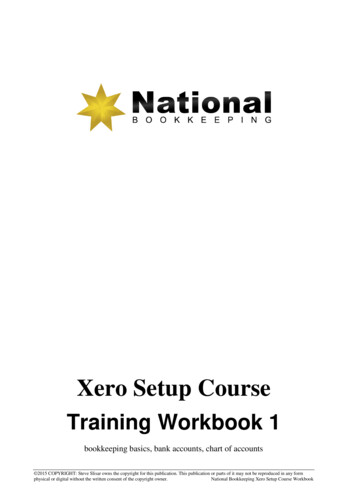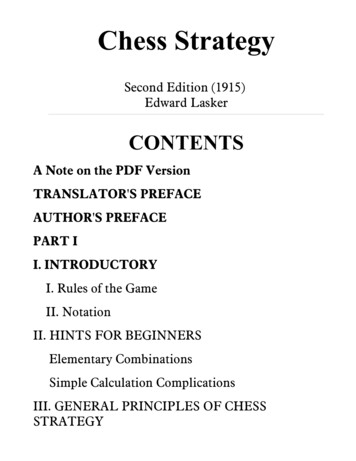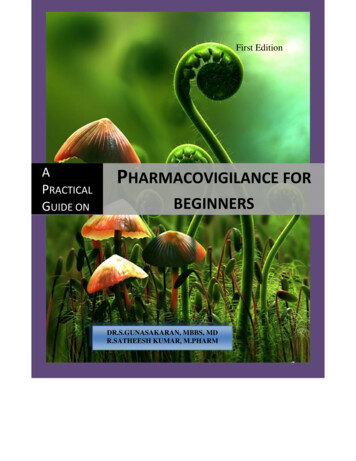
Transcription
A Practical Guide on Pharmacovigilance for BeginnersFirst EditionAPRACTICALGUIDE ONPHARMACOVIGILANCE FORBEGINNERSDR.S.GUNASAKARAN, MBBS, MDR.SATHEESH KUMAR, M.PHARM
A Practical Guide on Pharmacovigilance for BeginnersA Practical Guide on Pharmacovigilance for BeginnersFirst Edition, 2010Copyright Gunasakaran & Satheesh kumar, 2010.All rights reserved. No part of this publication may be reproduced ordistributed in any form or by any means (electronic, mechanical,photocopying, recording or otherwise), or stored in a database or retrievalsystem, without the written permission from the authors.The authors have made a conscientious effort to ensure that theinformation contained in this book is accurate and in accordance withthe accepted standards at the time of publication. However, in thisrapidly changing world guidelines and practices are subject to changewithout prior notification, therefore readers are advised to confirm theseas and when required.Rs. 350 (INR)Printed in IndiaPrinted at:Taramani Magalir Co-operative Press,Royapettah,Chennai,Tamilnadu, India.
A Practical Guide on Pharmacovigilance for BeginnersPREFACEThe Authors are pleased to present the First edition of “A PracticalGuide on Pharmacovigilance for Beginners”. This book is sketched toprovide a concise introduction along with practical applications ofpharmacovigilance that medical students, post graduates inpharmacology, pharmacy students and life science graduates canimpart during their academics as well as during their industrialexposures. This book is expected to provide basic knowledge about thedifferent aspects concerning adverse event reporting and will be an eyeopener for beginners who step into the field of pharmacovigilance.This book details the global and domestic aspects ofpharmacovigilance, various drug regulatory bodies guidelinesgoverning the pharmacovigilance, and different reporting systemsprevailing among various regulatory agencies along with detaileddescription of the standard terminologies used in the field ofpharmacovigilance. It also covers interesting case scenarios to ignitethe minds of bibliomaniacs – the future critiques of this book.Each chapter is thoughtfully developed to help the reader understandthe fundamentals of pharmacovigilance. We are greatly honor-bound toour colleagues who showed interests, encouragement & enthusiasm bydevoting their precious time in shape the dream into reality.Further suggestions, criticisms and elucidation are always welcomefrom the students and readers, which may be addressed to theauthor’s desk atDr.S.Gunasakaran, MBBS, MDPh : 91 98413 12609Email : drgunasakaran@gmail.com(Or)Mr. Satheesh kumar, M.PharmPh : 91 94431 60516Email : satheesh r2001@yahoo.com
A Practical Guide on Pharmacovigilance for BeginnersAUTHOR’S tigiousMadrasMedical College and with a couple of yearsexperience in the Pharmacovigilance field, Ihave desired to pen down my nce to the beginners. Thoughseveral books are available in the meadow ofpharmacovigilance, I tried to define this bookwith much versatility and significance.Every person who reads would get their feet wet and definitely persuadein the field of Pharmacovigilance. The book is concise, influencing thebeginners to understand the concept meticulously.This book intends to motivate the students for exploring the depth of thisfield by answering the ample case studies which will give basic insights toassess an adverse event and mode of reporting to the regulatory agencies.The supporting concept of this book is that, it provides answers to allexercise based questions and case scenarios.My contribution may be a drop to the ocean of pharmacovigilance but theentire journey of collecting knowledge to exhibit this book flooded me withan ocean of knowledge and clarity about Pharmacovigilance.The students and professionals who are yet to step into the industrialendeavors may not sense the feel of aliens and may outburst theignorance in the course of reading this book.The major objective of writing this book is to present the basic informationabout pharmacovigilance in a lucid, coherent, condensed and consistentform to furnish the innovative minds of graduates and post graduates ofpharmacy, life sciences and medical fields.
A Practical Guide on Pharmacovigilance for BeginnersAUTHOR’S DESKFrom the knowledge acquired through my Mastersin Pharmacy from the esteemed AnnamalaiUniversity and with my experience in the field ofPharmacovigilance, I preferred to share myknowledge in the field of Pharmacovigilance to theyoung scientists who would like to establish theircareer in Pharmacovigilance.Though several resources are available to gainknowledge in Pharmacovigilance, I felt that therewas a space left between the beginners and theresources available. This thought provoked me to author a book whichwould be a big boon for the beginners.This book contains the fundamentals of Pharmacovigilance, guidance toaccess the essential resources and exercises to provide hands onexperience on various aspects of Pharmacovigilance.This way I would like to differentiate this book “Practical Guide onPharmacovigilance for Beginners” from the other resources available. Aperson who grazes through the book would develop an idea of establishinghis / her career in the field of Pharmacovigilance.This book helps the beginnersPharmacovigilance scrupulously.tounderstandtheconceptsofThe passion for persuading in the Pharmacovigilance field for students willincrease as they go through the various case studies dealing from thebasic concepts of Pharmacovigilance through assessment and reporting ofadverse events to various regulatory authorities This process is madeeasy by providing answers to all exercise based questions.
A Practical Guide on Pharmacovigilance for BeginnersACKNOWLEDGEMENTSIt is with great pleasure, we record our deep respects, gratitude andindebtedness to Dr. Vikas soni, MD, Orchid Chemicals andPharmaceuticals, for his remarkable guidance, encouragement andselfless support which enabled us to pursue the work withperseverance and a skillful mind to view and analyze things. Hiscontagious enthusiasm was a source of energy to us in successfullycompleting this book under this generous guidance.We wish to express our sincere and heartful thanks to Mr.Ragavendra Rao, Managing Director, Orchid Chemicals andPharmaceuticals and Dr. C.B.Rao, Deputy Managing Director, OrchidChemicals and Pharmaceuticals for their untiring support,continuous suggestions and enduring encouragement in writing thisbook.We extend our sincere thanks and gratitude to our contributoryauthor Dr. Praveena Pearl, MD for her contribution in writing thechapter “Global perspective of Pharmacovigilance“.Our wholehearted thanks and gratitude to Dr. Abdul Hameed Khan,Mr. Srinivasa Reddy, Mrs. Narmadha Vijayaraja, Ms. Veena and Dr.Mohammad Shahid for their encouragement and continuous help inbringing out this book.We also extend our sincere thanks to our family members(Mrs.Radha Sambandan, Er.Inbasakaran, BE, ME, Mrs.PriyadarsiniInbasakaran, Mrs. Sakthi Satheesh & Ms. Deeksha) and our friendsfor their appropriate suggestions, moral support and timelyadjustments in bringing out this book.We also extend our personal thanks and gratefulness to all professorsand directors who enlightened us during our graduation and postgraduation studies.
A Practical Guide on Pharmacovigilance for BeginnersContentsPage no1. Standard Terms & Definitions inPharmacovigilance . 32. Global perspective of Pharmacovigilance . 213. Domestic perspective of Pharmacovigilance . 294. Guidelines and laws governing Pharmacovigilance . 415. Global Adverse Event Reporting systems andReporting forms 596. Individual Case Safety Reports . 1157. Periodic Safety Update Reports . 2618. Answers for Case studies 2679. Answers for Exercise based Questions . 272
A Practical Guide on Pharmacovigilance for BeginnersCHAPTER 1
A Practical Guide on Pharmacovigilance for BeginnersCHAPTER 1STANDARD TERMS AND DEFINITIONS INPHARMACOVIGILANCEThis chapter discuss in detail about the various standardterminologies and definitions used in adverse event reportingsystem and pharmacovigilance. The standard terms aredefined based on various drug regulatory guidelines and modified forbetter ease of understanding to the readers. The glossary of termsdescribed here covers most of the terminologies which are in use inthe field of pharmacovigilance and risk management.PharmacovigilanceWHO defines Pharmacovigilance as “the science and activitiesrelating to the detection, assessment, understanding and preventionof adverse effects or any other drug related problems.”Pharmacovigilance is the process and science of monitoring the safetyof medicines and taking action to reduce risks and increase benefitsfrom medicines.DrugA drug includes any substance or mixturemanufactured, sold or represented for use in:ofsubstances the diagnosis, treatment, mitigation or prevention of adisease, disorder or abnormal physical state, or its symptoms, in human beings oranimals, restoring, correcting or modifying organic functions in humanbeings or animals, or disinfection in premises in which food ismanufactured, prepared or kept.
A Practical Guide on Pharmacovigilance for BeginnersAdverse Event (or Adverse Experience)Any untoward medical occurrence in a patient or clinicalinvestigation subject administered a pharmaceutical product andwhich does not necessarily have to have a causal relationship withthis treatment.An adverse event (AE) can therefore be any unfavorable andunintended sign (including an abnormal laboratory finding, forexample), symptom, or disease temporally associated with the use ofa medicinal product, whether or not considered related to themedicinal product.Adverse Drug Reaction (ADR)In the pre-approval clinical experience with a new medicinal productor its new usages, particularly as the therapeutic dose(s) may not beestablished:all noxious and unintended responses to a medicinal product relatedto any dose should be considered adverse drug reactions.The phrase "responses to a medicinal product" means that a causalrelationship between a medicinal product and an adverse event is atleast a reasonable possibility, i.e., the relationship cannot be ruledout.Regarding marketed medicinal products, a well-accepted definition ofan adverse drug reaction in the post-marketing setting is found inWHO Technical Report 498 [1972] and reads as follows:A response to a drug which is noxious and unintended and whichoccurs at doses normally used in man for prophylaxis, diagnosis, ortherapy of disease or for modification of physiological function.Unlisted / Unexpected Adverse Drug ReactionAn adverse reaction, the nature or severity of which is not consistentwith the applicable product information (e.g., Investigator's Brochurefor an unapproved investigational medicinal product and prescribinginformation / Summary of Product Characteristics (SmPC) formarketed products).Listed / Expected Adverse Drug ReactionAn ADR whose nature, severity, specificity, and outcome areconsistent with the information in the CCSI.
A Practical Guide on Pharmacovigilance for BeginnersChallengeAdministration of a suspect product by any route.DechallengeWithdrawal of a suspect product from a patient's therapeuticregimen.Negative DechallengeContinued presence of an adverse experience after withdrawal of thesuspect product.Positive DechallengePartial or complete disappearance of an adverse experience afterwithdrawal of the suspect product.RechallengeReintroduction of a suspect product suspected of having caused anadverse experience following a positive dechallenge.Negative RechallengeFailure of the product, when reintroduced, to produce signs orsymptoms similar to those observed when the suspect product waspreviously introduced.Positive RechallengeReoccurrence of similar signs and symptoms upon reintroduction ofthe suspect product.Serious Adverse Event or Adverse Drug ReactionA serious adverse event (experience) or reaction is any untowardmedical occurrence that at any dose:* results in death,* is life-threatening,The term "life-threatening" in the definition of "serious"refers to an event in which the patient was at risk of deathat the time of the event; it does not refer to an event whichhypothetically might have caused death if it were moresevere.* requires inpatient hospitalisation or prolongation of existinghospitalisation,* results in persistent or significant disability/incapacity,* is a congenital anomaly/birth defect.
A Practical Guide on Pharmacovigilance for BeginnersCASE SCENARIOS
A Practical Guide on Pharmacovigilance for BeginnersCase scenarios:Case 1A Dermatologist called KA pharmaceuticals and reported that a 21year old male patient named Johnson had urticaria after intake ofTerbinafine tablets.Check the criteria of identifiable patient in this case.Yes1.2.3.4.5.NoName/InitialsPatient IDAge /D.O.BAge categorySexWhether this case report fulfills the criteria of an identifiable patient.?Yes/NoCase 2Dr. Johnson mailed PJ pharmaceuticals that a young mancomplained of severe abdominal pain after the intake of amoxicillintablets.Check the criteria of identifiable patient in this case.Yes1.2.3.4.5.NoName/InitialsPatient IDAge /D.O.BAge categorySexWhether this case report fulfills the criteria of an identifiable patient.?Yes/No
A Practical Guide on Pharmacovigilance for BeginnersCase 9A Physician called CFC pharmaceuticals and informed that fewpatients complained of severe burning sensation at the injection siteafter administration of methylcobalamin injection in the gluteal regionin the past one week.Check the criteria of identifiable patient in this case.Yes1.2.3.4.5.NoName/InitialsPatient IDAge /D.O.BAge categorySexWhether this case report fulfills the criteria of an identifiable patient.?Yes / NoCase 10A nurse informed that a patient named Mr. IK complained of diarrheaafter intake of erthyromycin tablets.Check the criteria of identifiable patient in this case.Yes1.2.3.4.5.NoName/InitialsPatient IDAge /D.O.BAge categorySexWhether this case report fulfills the criteria of an identifiable patient.?Yes / No
A Practical Guide on Pharmacovigilance for BeginnersCase 70A published article states that 2 cancer patients was admitted in amultispecality hospital in Mexico with history of metastatic carinoidtumors for the past 3 years. Treatment with octreotide was started atthe dose of 100-600 mcg per day in 2-4 divided doses. One of thepatient complained of tremors, palpitations and giddiness 20 minafter the intravenous infusion of octreotide Assess the case based onthe Product Information provided in the next page.Check the criteria of reportability:Yes NoIdentifiable patientIdentifiable sourceSuspect medicationEvent / outcomeWhether this case is reportable or not.?Yes / NoAssessment of seriousness:SeriousNon-seriousIf serious, check the appropriate box (es) below: DeathLife-threateningHospitalization – Initial or prolongedDisability or permanent damageRequired intervention to preventpermanent impairment damage (device)Congenital anomaly with childOther serious (important medical events)Assessment of Expectedness:ExpectedUnexpected
A Practical Guide on Pharmacovigilance for BeginnersProduct information of Octerotide:Hypo/HyperglycemiaHypoglycemia and hyperglycemia occurred in 3% and 16% of acromegalicpatients, respectively, but only in about 1.5% of other patients.Symptoms of hypoglycemia were noted in approximately 2% of patients.HypothyroidismIn acromegalics, biochemical hypothyroidism alone occurred in 12%while goiter occurred in 6% during Sandostatin therapy. In patientswithout acromegaly, hypothyroidism has only been reported in severalisolated patients and goiter has not been reported.Pain on injection was reported in 7.7%, headache in 6% and dizziness in5%. Pancreatitis was also.Adverse Events 1%-4%Other events (relationship to drug not established), each observed in 1%4% of patients, included fatigue, weakness, pruritus, joint pain,backache, urinary tract infection, cold symptoms, flu symptoms,injection site hematoma, bruise, edema, flushing, blurred vision,pollakiuria, fat malabsorption, hair loss, visual disturbance anddepression.Adverse Events 1%Events reported in less than 1% of patients and for which relationship todrug is not established are listed: Gastrointestinal: hepatitis, jaundice,increase in liver enzymes, GI bleeding, hemorrhoids, appendicitis,gastric/peptic ulcer, gallbladder polyp; Integumentary: rash, cellulitis,petechiae, urticaria, basal cell carcinoma; Musculoskeletal: arthritis,joint effusion, muscle pain, Raynaud's phenomenon; Cardiovascular:chest pain, shortness of breath, thrombophlebitis, ischemia, congestiveheart failure, hypertension, hypertensive reaction, palpitations,orthostatic BP decrease, tachycardia; CNS: anxiety, libido decrease,syncope, tremor, seizure, vertigo, Bell's Palsy, paranoia, pituitaryapoplexy, increased intraocular pressure, amnesia, hearing e,statusasthmaticus; Endocrine: galactorrhea, hypoadrenalism, diabetesinsipidus, gynecomastia, amenorrhea, polymenorrhea, oligomenorrhea
A Practical Guide on Pharmacovigilance for BeginnersCase 71A Scientific literature states that a 45 year old male patient who wassuffering from parkinsonism for the past 2 years was started withRopinirole 2mg extended release tablets once daily. After two weeks,the dose of Ropinirole was incremented at the rate of 2mg/day. Thepatient experienced hallucinations, dyskinesia and dizziness after thetitration of dosage. Assess the case based on the Product Informationprovided in the next page.Check the criteria of reportability:Yes NoIdentifiable patientIdentifiable sourceSuspect medicationEvent / outcomeWhether this case is reportable or not.?Yes / NoAssessment of seriousness:SeriousNon-seriousIf serious, check the appropriate box (es) below: DeathLife-threateningHospitalization – Initial or prolongedDisability or permanent damageRequired intervention to preventpermanent impairment damage (device)Congenital anomaly with childOther serious (important medical events)Assessment of Expectedness:ExpectedUnexpected
A Practical Guide on Pharmacovigilance for BeginnersProduct Information of Ropinirole Extended Release Tablets:The following adverse reactions are described in the product informationlabel: Falling asleep during activities of daily livingSyncopeSymptomatic hypotension, hypotension, postural/orthostatichypotensionElevation of blood pressure and changes in heart rateHallucinationDyskinesiaMajor psychotic disordersEvents with dopaminergic therapyRetinal pathologyCardiovascular: palpitation, vasodilation, tachycardia, heart ascularaccident,hypertensive crisis, angina pectoris, orthostatic hypotension, cardiacrhythm disturbances, cardiogenic shockHematology: hemolytic anemiaGastrointestinal: flatulence, dry mouth or throat, constipation,gastrointestinal hemorrhage, pancreatitis, abnormal liver function tests,dyspepsiaNervous/Psychiatric: somnolence,depression, insomnia, ry: alopecia, increased sweating, pemphigus, pruritus,exfoliative dermatitis, photosensitivity reaction, dermatopolymyositisThe incidence of adverse reactions was not clearly different betweenwomen and men.
A Practical Guide on Pharmacovigilance for BeginnersCase 103Dr. Viswanthan M.D. D.M., a cardiologist prescribed digoxin tabletsfor 56 year old male suffering from grade II congestive cardiac failureaccording to NYHA classification. 3 days after the initiation of therapythe patient complained shortness of breath, chest pain, dizziness,nausea, nervousness and feelings of impending doom. Onauscultation, the heart rate found to be 240 beats / min. The plasmaconcentration of digoxin is found to be 12 microgram / ml. EEGshowed characteristic features of type I atrial flutter. Cardioversionwas done to revert back to sinus rhythm. Atrial flutter was notmentioned in the product information of digoxin.Check the criteria of reportability:Yes NoIdentifiable patientIdentifiable sourceSuspect medicationEvent / outcomeWhether this case is reportable or not.?Yes / NoAssessment of seriousness:SeriousNon-seriousIf serious, check the appropriate box (es) below: Death Life-threatening Hospitalization – Initial or prolonged Disability or permanent damage Required intervention to preventpermanent impairment damage (device) Congenital anomaly with child Other serious (important medical events)Assessment of Expectedness:ExpectedUnexpected
A Practical Guide on Pharmacovigilance for BeginnersEncircle the appropriate score:QuestionsPrevious conclusive reports on thisreactionDid the ADR appear after thesuspected drug was administered?Did ADR improve when the drugwas discontinued or a specificantagonist was givenADRappearanceafterdrugreadministrationAre there alternative causes otherthan the incriminated drugDid the reaction appear whenplacebo was given?Was the drug detected in blood attoxic levels?ADR more severe with large dose,less severe with small doseDid the patient have a similarreaction to the same or similardrug in any previous exposure?Was the ADR confirmed by anyobjective evidence?Total ScoreYesNoUnsure 100 2-10 100 2-10-1 20-1 10 100 100 100 100Naranjo’s score: Causality assessment: Doubtful / possible / probable / definiteWHO probability scale: Certain / probable / possible / unlikely /unclassified / unassessableTime frame of reporting to licensing authorityExpedited 7 daysExpedited 15 daysPSURDSUR
A Practical Guide on Pharmacovigilance for BeginnersCase 104A 72 year old female patient suffering from nosocomial pneumoniawas admitted in ICU of Chennai Medical centre. She was started onintravenous ceftriaxone 2 g twice daily along with amikacinintramuscular injection. The patient complained nausea, dyspepsia,giddiness and blurring of vision two days later. The physician reducedthe dose of ceftriaxone to 1 g in two divided dose daily. The symptomsresolved and the patient had mild nauseating sensation only. All theforesaid side effects are mentioned in the summary of productcharacteristics of ceftriaxone injection.Check the criteria of reportability: YesNoIdentifiable patientIdentifiable sourceSuspect medicationEvent / outcomeWhether this case is reportable or not.?Yes / NoAssessment of seriousness:SeriousNon-seriousIf serious, check the appropriate box (es) below: Death Life-threatening Hospitalization – Initial or prolonged Disability or permanent damage Required intervention to preventpermanent impairment damage (device) Congenital anomaly with child Other serious (important medical events)Assessment of Expectedness:ExpectedUnexpected
A Practical Guide on Pharmacovigilance for BeginnersEncircle the appropriate score:QuestionsPrevious conclusive reports on thisreactionDid the ADR appear after thesuspected drug was administered?Did ADR improve when the drugwas discontinued or a specificantagonist was givenADRappearanceafterdrugreadministrationAre there alternative causes otherthan the incriminated drugDid the reaction appear whenplacebo was given?Was the drug detected in blood attoxic levels?ADR more severe with large dose,less severe with small doseDid the patient have a similarreaction to the same or similardrug in any previous exposure?Was the ADR confirmed by anyobjective evidence?Total ScoreYesNoUnsure 100 2-10 100 2-10-1 20-1 10 100 100 100 100Naranjo’s score: Causality assessment: Doubtful / possible / probable / definiteWHO probability scale: Certain / probable / possible / unlikely /unclassified / unassessableTime frame of reporting to licensing authorityExpedited 7 daysExpedited 15 daysPSURDSUR
A Practical Guide on Pharmacovigilance for BeginnersCase 105A scientific literature states that a 47 year old male patient wasprescribed cephalexin capsules 500 mg twice daily for the treatmentof upper respiratory tract infections. Ten minutes after the intake ofcephalexin capsule the patient developed itching, eczema, tightness inthe chest and hypotension. He was rushed to the nearby hospital. Thedrug was discontinued and was given symptomatic treatment foranaphylactic reaction. The family physician noted that the patient hadprevious history of hypersensitivity to penicillin two years back. Thepatient had no relevant medical or treatment history.Check the criteria of reportability: YesNoIdentifiable patientIdentifiable sourceSuspect medicationEvent / outcomeWhether this case is reportable or not.?Yes / NoAssessment of seriousness:SeriousNon-seriousIf serious, check the appropriate box (es) below: Death Life-threatening Hospitalization – Initial or prolonged Disability or permanent damage Required intervention to preventpermanent impairment damage (device) Congenital anomaly with child Other serious (important medical events)Assessment of Expectedness:ExpectedUnexpected
A Practical Guide on Pharmacovigilance for BeginnersEncircle the appropriate score:QuestionsPrevious conclusive reports on thisreactionDid the ADR appear after thesuspected drug was administered?Did ADR improve when the drugwas discontinued or a specificantagonist was givenADRappearanceafterdrugreadministrationAre there alternative causes otherthan the incriminated drugDid the reaction appear whenplacebo was given?Was the drug detected in blood attoxic levels?ADR more severe with large dose,less severe with small doseDid the patient have a similarreaction to the same or similardrug in any previous exposure?Was the ADR confirmed by anyobjective evidence?Total ScoreYesNoUnsure 100 2-10 100 2-10-1 20-1 10 100 100 100 100Naranjo’s score: Causality assessment: Doubtful / possible / probable / definiteWHO probability scale: Certain / probable / possible / unlikely /unclassified / unassessableTime frame of reporting to licensing authorityExpedited 7 daysExpedited 15 daysPSURDSUR
A Practical Guide on Pharmacovigilance for BeginnersCase 106Dr. Alexander called LND laboratories and informed that his 55 yearold known hypertensive patient was on enalapril 5 mg once daily forthe past two years. On routine follow up, his blood pressure wasfound to be 154 / 96 mmHg. The physician added 5 mg amlodipinebesylate twice daily along with enalapril. Two days after the initiatonof treatment with amlodipine, the patient experienced anorexia,constipation, dyspepsia, dysphagia and dysuria. The patient calledupon his family physician and informed him of the adverse reactions.The physician advised him to reduce the dose of amlodipine 5 mg toonce daily. The symptoms resolved on the next day of reduction ofdosage. Assess the case based on the product information provided inthe next page.Check the criteria of reportability:Yes NoIdentifiable patientIdentifiable sourceSuspect medicationEvent / outcomeWhether this case is reportable or not.?Yes / NoAssessment of seriousness:SeriousNon-seriousIf serious, check the appropriate box (es) below: Death Life-threatening Hospitalization – Initial or prolonged Disability or permanent damage Required intervention to preventpermanent impairment damage (device) Congenital anomaly with child Other serious (important medical events)Assessment of Expectedness:ExpectedUnexpected
A Practical Guide on Pharmacovigilance for BeginnersEncircle the appropriate score:QuestionsPrevious conclusive reports on thisreactionDid the ADR appear after thesuspected drug was administered?Did ADR improve when the drugwas discontinued or a specificantagonist was givenADRappearanceafterdrugreadministrationAre there alternative causes otherthan the incriminated drugDid the reaction appear whenplacebo was given?Was the drug detected in blood attoxic levels?ADR more severe with large dose,less severe with small doseDid the patient have a similarreaction to the same or similardrug in any previous exposure?Was the ADR confirmed by anyobjective evidence?Total ScoreYesNoUnsure 100 2-10 100 2-10-1 20-1 10 100 100 100 100Naranjo’s score: Causality assessment: Doubtful / possible / probable / definiteWHO probability scale: Certain / probable / possible / unlikely /unclassified / unassessableTime frame of reporting to licensing authorityExpedited 7 daysExpedited 15 daysPSURDSUR
A Practical Guide on Pharmacovigilance for BeginnersThe following adverse events are listed in the product information ofamlodipine besylate:Cardiovascular: arrhythmia (including ventricular tachycardia and atrialfibrillation), bradycardia, chest pain, hypotension, peripheral ischemia,syncope, tachycardia, postural dizziness, postural hypotension,vasculitis.Central and Peripheral Nervous System: hypoesthesia, neuropathyperipheral, paresthesia, tremor, vertigo.Gastrointestinal: anorexia, constipation, dyspepsia, dysphagia,diarrhea, flatulence, pancreatitis, vomiting, gingival hyperplasia.General: allergic reaction, asthenia, back pain, hot flushes, malaise,pain, rigors, weight gain, weight decrease.Musculoskeletal System: arthralgia, arthrosis, muscle cramps, myalgia.Psychiatric: sexual dysfunction, insomnia, nervousness, depression,abnormal dreams, anxiety, depersonalization.Respiratory System: dyspnea, epistaxis.Skin and Appendages: angioedema, erythema multiforme, pruritus,rash, rash erythematous, rash maculopapular.Special Senses: abnormal vision, conjunctivitis, diplopia, eye pain,tinnitus.Urinary System: micturition frequency, micturition disorder, nocturia.Autonomic Nervous System: dry mouth, sweating increased.Metabolic and Nutritional: hyperglyc
was a space left between the beginners and the resources available. This thought provoked me to author a book which would be a big boon for the beginners. This book contains the fundamentals of Pharmacovigilance, guidance to access the essential resources and exercises to provide hands on experience on various aspects of Pharmacovigilance.





